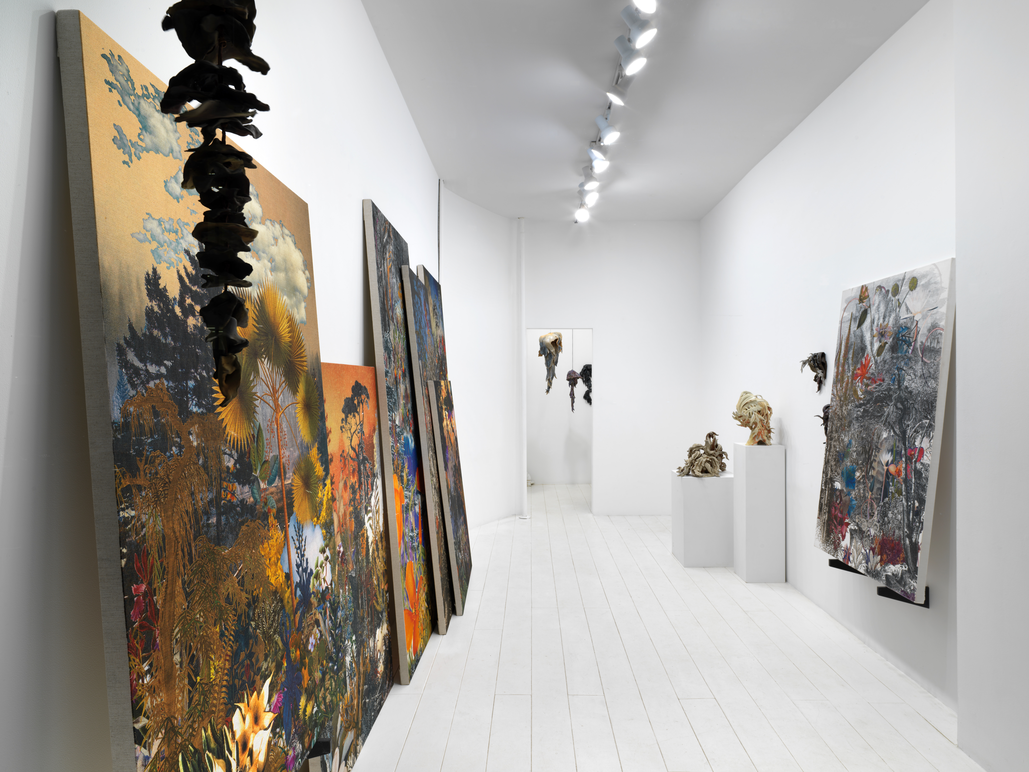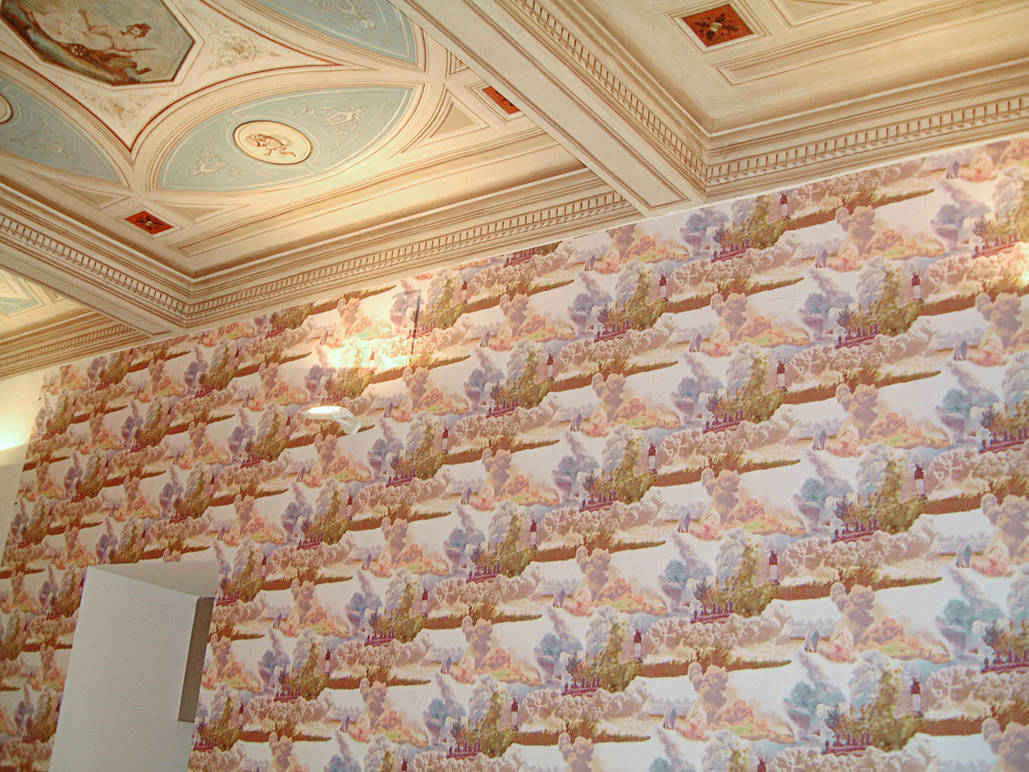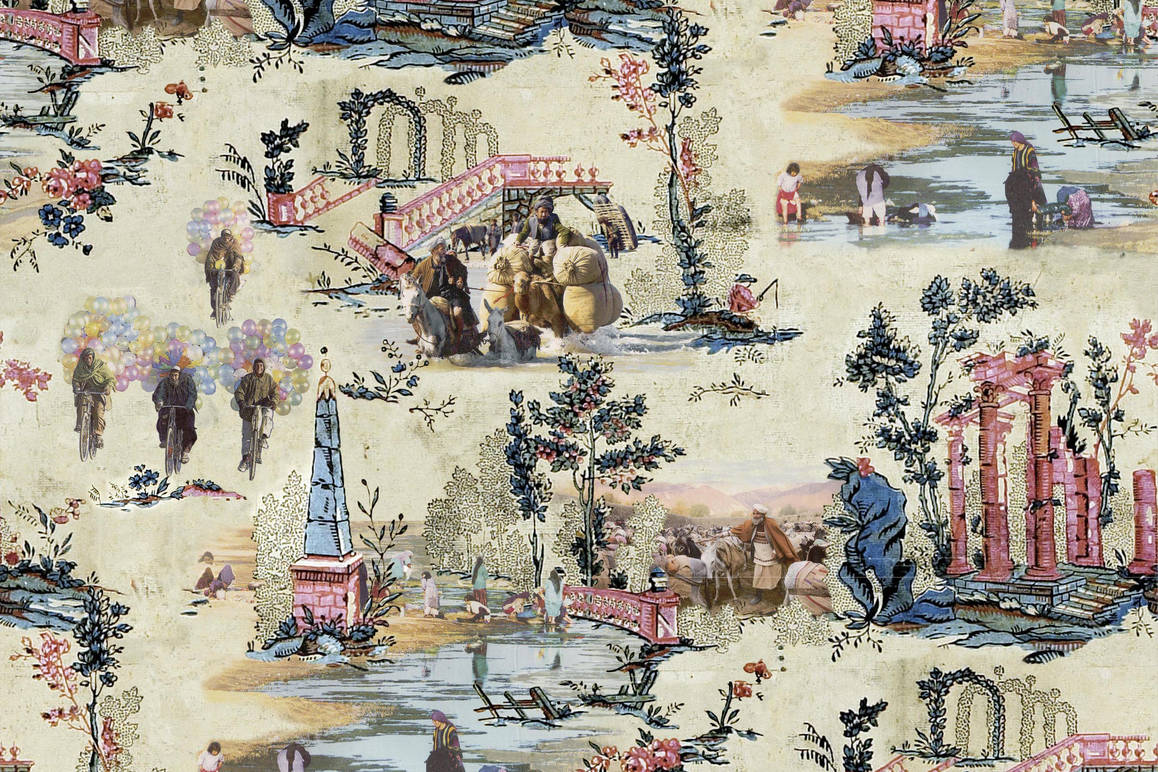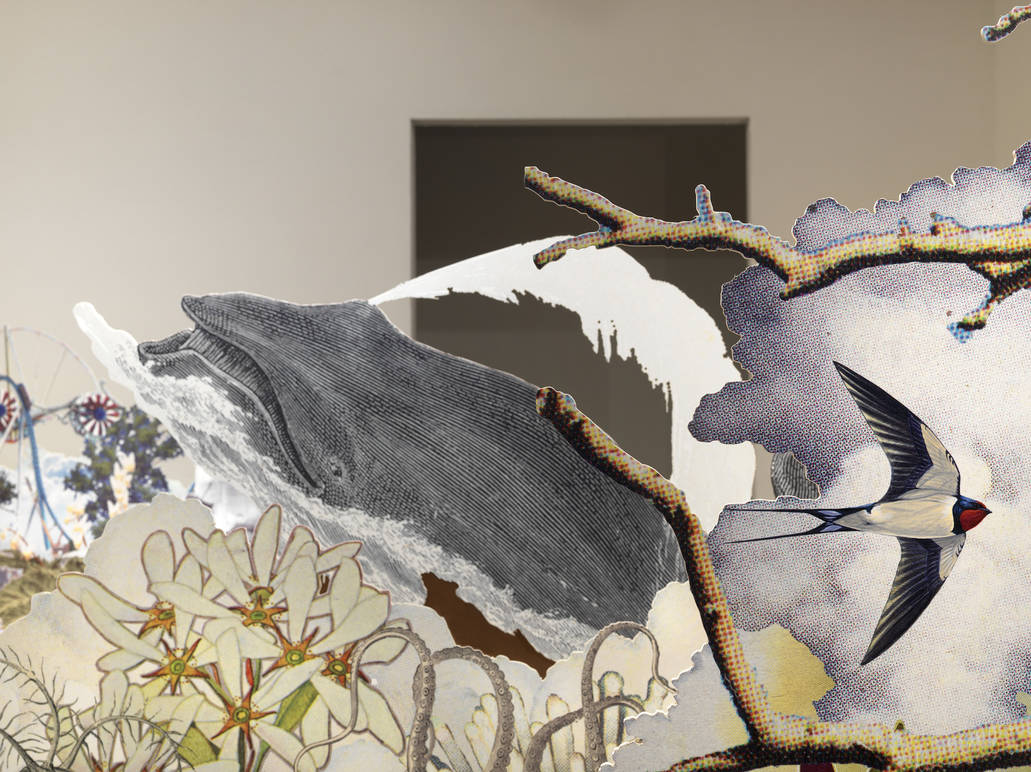Confronting Reality in Francesco Simeti’s “Imaginary” Worlds
Palermo-born, New York-based artist Francesco Simeti recently inaugurated an exhibition at Assembly Room, a Lower East Side art gallery whose goal is to build a community of independent women curators. Founded in the summer of 2018 by three international curators, the space hosts a variety of activities including workshops, screenings, talks, and professional advancement programs. The exhibitions are realized by visiting curators as well as by the co-founders themselves.
For Simeti’s show, which opened on September 13th and will run through October 20th, curator Yulia Topchiy, Assembly Room co-founder along with Paola Gallio and Natasha Becker, turned the gallery into an immersive installation consisting of ceramics and digital prints on canvas. The exhibition is titled Refugium, “a technical term for a biological refuge [...] it primarily designates a landscape where animals and plants pursue lives protected from exploitation and pursuit” according to Barry Lopez in Home Ground, a Guide to the American Landscape.
And that’s exactly what the worlds depicted in Simeti’s canvases feel like. Refuges, in which a variety of plants and animals from across the planet and across the ages come together, layered on top of each other. Beautiful post-apocalyptic visions of what the Earth will be like once we are gone. Suggesting that the same nature we are destroying - and you can discern traces of this destruction in elements such as nuclear explosions, gas raids, and forest fires hidden in the background - will live on, alterned, but ultimately triumphant.
You can only identify these elements once you get up close, step inside the canvas, scan through all the layers, something that you’ll likely be compelled to do by the unusual disposition of the works, which aren’t hung but rather stacked on top of each other. An intentional decision not simply brought about by size constraints, the curator explains (e.d. the gallery is quite small). “I’ve always had this thing for hiding things, making you look for them,” he explains. This gives the show an interactive, immersive dimension, further amplified by the presence of Simeti’s sculptural works, something which he has started working on more recently, fueled by the desire to go back to using his hands.
These fascinating ceramics take the shape of dynamic forms, plant-like, animal-like but also parlty supernatural, almost alien. “I have pretty minimal tastes when it comes to furniture, to clothing, but my work certainly has a very baroque quality to it,” he says, and you can clearly see it - perhaps an expression of his Sicilian origins as some including the artist himself have suggested - in its abundance, its twisted natural forms. A wilder, feral baroque.
The pieces seem to be in the process of changing, morphing. Like the canvases, they are crafted through accumulation, their many “limbs” added on as the work progresses.
Simeti explains his process during my visit to his studio in Gowanus, Brooklyn and the unfinished yet to be assembled pieces layed out on his table - part of a large project for the health department headquarters in Portland, Oregon - perfectly illustrate it. “When do you know a work is finished?” I ask, to which he replies “I don’t. I keep moving pieces around until I have to stop.”
There are many things inside the artist’s spacious studio, which he currently shares with another person, whom he assures me is the owner of the large stuffed bear I spot upon entering. Among Simeti’s own posessions are numerous botanical books, filled with illustrations of various plants, trees, flowers, one of the major sources feeding the extensive archives he uses to create his complex compositions.
This interest in plants comes from his family. “My father was a university professor in the agrarian department and my mother always had a passion for gardening. We have an agricultural business, which my sister is carrying on in Alcamo, near Trapani,” he explains.
“When I was younger I had to help out there and I hated it,” he confesses. “Then there was a shift. Now I enjoy gardening. It came about through a strange process, through my artistic practice, which slowly shifted towards nature.”
When he began his artistic career, after attending the Bologna Academy of Fine Art, where he specialized in scultpure, his focus was more overtly political. “I tried to be an artist in Palermo,” he explains, “but it was a very different reality in the early 90s and so at one point I made the leap and came to New York.”
Though his mother lived in Italy for a large part of her life, she is American, originally from New England so he also has a US passport. When I ask him how this side of his identity influenced his practice he immediately cites the use of wallpaper, a medium he began exploring early on and one not typically found in Sicilian homes.
“For me wallpaper is a metaphor for something that surrounds us everyday but that we don’t really focus on,” he explains. “It echoes the way we look at the wars and crisis that happen all around us deciding not to engage or really pay attention to it all, maybe as a defensive mechanism, and because the media overload turns all of it into white noise.”
And in fact, as he was settling into the city - initially working as an art handler at the Guggenheim, which gave him some access to the art scene, and participating in various programs such as the Bronx Museum’s Artists in the Marketplace initiative, to meet people, gain knowledge of the industry - he focused on exploring themes such as “war, migration, displacement, through our reading of the news, how these things are depicted in the media.”
His wallpapers tend to look like beautiful decorative objects at first, with innoffensive motifs. But, upon closer inspection, you discover they are actually depicting wars, bombings, suffering, people, faces you can’t look away from. And example of this is his 2002 site specific installation at Villa delle Rose in Bologna for a project called Officina America. Simeti created a gorgeous wallpaper matching the colors of the hall’s ornate ceiling. Only when looked at up close, does the work, appropriately entitled Watching the War, reveal to be made of images of the bombings in Tora Bora, Afghanistan.
The following year, Simeti, who still today works regularly between Italy and the United States, realized a similar piece for the RISD Museum, this time adding an additional layer, another reading. This work, titled Arabian Nights, was made after President George W. Bush’s overzealous announcement that he was retiring the troops from Afghanistan. Here, the artist juxtaposes folkloric, naive images of “liberated Afghanistan” added onto a frilly chinoiserie-style wallpaper and what appears to simply be a blue background, recreating the typical 18th century decorative fashion, complete with period furniture from RISD’s decorative arts department.
However, the blue background, the background to the background, is actually a collage of countless figures and faces belonging to migrants, victims of all the wars that were taking place around the world at that time. All the white noise. Representing the contrast between a superficial reading of the facts and what’s actually happening behind the big media headlines.
“‘Classic’ political art like the work of Barbara Kruger are incredible works,” Simeti says, “but in a way they’re not very effective because they’re so explicit and they still allow the spectator to not get implicated. What I do is sort of ‘trick’ the viewer into leaning in and once you see it up close you can’t look away that easily.”
This tactic is present in all of Simeti’s works, even as his practice began to shift focus, in large part inspired by his experience in New York. In 1998, he had his first studio in Soho/Chinatown, at Broadway e White Street. “From there I went to Williamsburg, North 3rd and Bedford,” both incredibly trendy (and pricey) locations nowadays. He’s been in Gowanus, a former industrial area of Brooklyn mostly known for the infamously polluted Gowanus Canal, for quite some time now. Over the past few years, he’s witnessed the area change a lot as well, beginning to turn into a somewhat hip residential neighborhood.
This informed his shift of focus towards the effect of human activity on nature and landscape. “At one point, I noticed a similarity between industrial structures and amusement parks, which also serve as a metaphor for how we are behaving towards the environment. Lightly, as if it were a game.”
This reflection prompted the realisation of his 2017 installation Swell at Open Source in Gowanus. An animated three-dimensional version of his canvases or wallpapers, where several layers of varied forms and figures that one would never expect to see together coexist. It all feels very playful, there is a ferris wheel and other amusement park elements, even the toxic smoke sprayed by uniformed workers onto the scene evokes japanese prints with its elegant curls and embellishments. It also features Sludgie, the whale who accidentally entered the Gowanus Canal in 2007 and died 24 hours later, becoming an icon representing the state of the canal.
Despite the playfulness, or through it rather, the work mimics our own behavior towards environmental issues: we take them lightly, but what we are doing is very serious, we are destroying environments. Gowanus for one was once home to a thriving ecosystem before it was heavily industrialized, polluting the canal.
Due in part to the themes he explores, Francesco receives a lot of commissions for public art works. “It’s a separate world. It has a lot of visibility where it is but almost none in the art world.”
With these though, he has the chance to explore different mediums from tiles to stained glass, wood panels, mosaics.
The artist made the stained glass windows of the Bensonhurst subway station in Brooklyn, where he created an imaginary landscape combining imagery of Eastern landscapes and Italian Renaissance gardens, playing with the neighborhood’s mixed identity, Italian on the one hand - Bensonhurst is considered the borough’s Little Italy - and Chinese on the other.
These landscapes are similar to the ones shown in Refugium. They’re imaginary yes, but hint to a very real phenomenon. To how human activity is drastically altering ecosystems and climate change is causing plants to grow where they would not normally be found.
Apparantly, the artist tells me, investors have started buying land for vineyards in England now because they are expecting the climate there to be ideal for growing grapes 10 years from now. A callous reaction, to say the least, to a clear sign of the rapid evolution of climate change. “They’ll have the land to grow grapes but no people to drink the wine,” he comments.

















































i-Italy
Facebook
Google+
This work may not be reproduced, in whole or in part, without prior written permission.
Questo lavoro non può essere riprodotto, in tutto o in parte, senza permesso scritto.